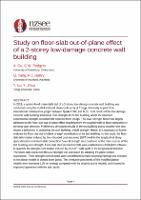| dc.contributor.author | Gu, Anqi | |
| dc.contributor.author | Henry, Richard | |
| dc.contributor.author | Rodgers, Geoffrey | |
| dc.contributor.author | Yang, Qun | |
| dc.contributor.author | Lu, Yiqiu | |
| dc.contributor.author | Zhou, Ying | |
| dc.date.accessioned | 2023-02-21T01:18:01Z | |
| dc.date.available | 2023-02-21T01:18:01Z | |
| dc.date.issued | 2022-04-27 | |
| dc.identifier.uri | https://repo.nzsee.org.nz/xmlui/handle/nzsee/2464 | |
| dc.description.abstract | In 2019, a system-level shake-table test of a 2-storey low-damage concrete wall building was conducted using the multi-functional shake-table array at Tongji University as part of an international collaborative project between QuakeCoRE and ILEE. Test results of the low-damage concrete wall building showed an over-strength of the test building where the observed experimental strength exceeded that expected from design. This over-strength factor was largely attributed to the floor-slab out-of-plane effect resulting from the coupled wall-to-floor connection in the long-span direction. Preliminary simulation results of the test building planar models have also shown a deficiency in predicting the wall building overall strength. Hence, it is necessary to further evaluate the floor slab out-of-plane strength contribution to the test building. In this study, the floor slab deformation induced by the unbonded post-tensioned (UPT) wall in the longitudinal (long-span) direction and beam-slab connection flexural strength are considered as the main sources of the test building over-strength. Floor slab shell element models were established in ABAQUS software to quantify the strength contribution induced by the UPT wall uplift in the longitudinal direction. The beam-slab connection flexural strength was calculated by adopting the plane section assumption. These strength contributions were simplified to lumped rotational springs and included in the planar models at slotted-beam joints. The overturning moments of the modified planar models were increased 12% on average compared with the original planar models, and showed an improved agreement with the test results. | |
| dc.language.iso | en | |
| dc.publisher | New Zealand Society for Earthquake Engineering | |
| dc.relation.ispartofseries | 2022;4 | |
| dc.subject | Other topic related to earthquake engineering and its application | |
| dc.subject | Quantifying and addressing uncertainties in seismic design | |
| dc.title | Study on floor-slab out-of-plane effect of a 2-storey low-damage concrete wall building | |
| dc.type | Article | |

